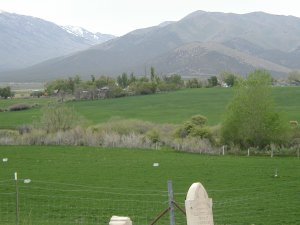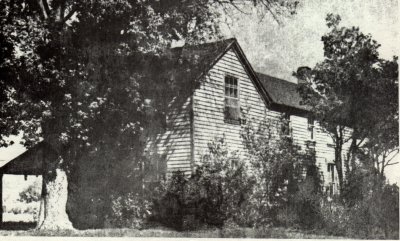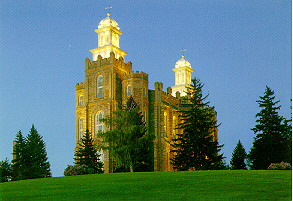
SKETCH OF HER LIFE
TOLD BY PAULINE BURRIDGE NEDDO TO HER GRAND-DAUGHTER, JEAN HUTCHISON.
Written in 1937
editor's note: Bill Harms sent me this scanned
copy of the original history in 2003. I doscovered it again as I was looking
back through some old e-mails. I added it to my Burridge web-site in April,
2004. The grammer and spelling were as originally recorded by Jean.
My parents were married November 16, 1848. They had six living children three sons and three daughters. [ed. note only 3, Thomas, Pauline and Charlotte lived to adulthood] At the time of the Crimean War, my father had to go to Foreign lands and while on the Island of Malta in the Meditarrian Sea, he found a Mormon tract telling of the Restoration of the Gospel and where the meetings were held. He attended and bought a Book of Mormon.
He read it and was baptised on July 4, 1852. Father was put in prison for three months for preaching the gospel to the soldiers. Then he was discharged and sent to England where he met Apostal Willard Richards who called him on a mission and sent him back to the Italian Mission. Father and Mother went right back and kept a home for the missionaries until the winter of 1854-55. They then went back to England and started for America.
May 1855 when they landed in America, they had come as emigrants with seven grown people and three children in one wagon. So clothing and provisions were very meager Indeed and the conditions necessitated their walking every step of the way. Dear mother was foot sore and weary, she being with child, her fourth child. It was born in Utah, January 24, 1856. They arrived in Utah October 24, 1855. The first winter was spent on Rush Lake. Father was employed by P.O. Rockwell [ed. note s/b O. P. Rockwell], for pay he received a cow and some potatoes. It was a very hard winter. The cow died and all the potatoes were frozen. Mother buried her baby the next winter while Father was standing guard to keep the soldiers back during the Echo Canyon War.
I was born in Tooele, in a nice adobe house just before the move South on February 26, 1858. I was just six weeks old at the time of the move. When we came back, we settled in Rush Valley [ed. note near the present town of Clover, Utah] and lived in a dug out on Luke S. Johnsons farm.

[ed note - The dugout was located in the hill across the creek from the Clover, UT cemetery]
In 1866, Mother's mother, my grandmother, my Aunt and two children came to Utah with ox teams. The next spring Father was called to England on a mission. That summer the grasshoppers came in millions darkening the very sun and eating every green thing. We never had had an abundance of food but now we were hungary [sic] all the time. I just do not know how my dear mother and Aunt ever did get food for us. They did every kind of labor. The lord blessed us all with health and strength and we got along. The next spring my brother Tom put in ten acres of wheat. It came up beautiful and was about two inches high when the grasshoppers hatched out and ate it bare as the floor. We children went up to the fields one day and caught a large sack of grasshoppers and brought them down to the settlement. There were none down there and when mother looked in the sack, she said, "Oh, what shall I ever do?" Aunt Ann said, "Boil them Hannah, for the chickens." So they did which saved us carrying them back to the field, which was about four miles away.
Mima Moir Caldwell [see Bill Harm's note below], we call her Aunt Mimie now, was one of my Aunts children when they came from Scotland and so when father was on this mission and Aunt Ann and mother had to work so hard we were always together because they lived with us as did my grandmother Jean Shaw, wife of John Shaw,. One day our cow had a calf and we were all quite excited. At last, the time came when we had enough cream saved up to have our very first churning. Well Mima and I were so glad that we both took hold of the churn dash and went jumping around and churning. Of course the churn tipped over and all the cream went on the floor We were horror stricken but Grandma Shaw said in her quaint Scotch, never mind and she wiped it up with a cloth but of course there was a greasy spot on the floor. Then Grandma took her little rocking chair and put it over the spot saying, "I'll sit on it."
At about this same time mother and Aunt Ann left us kids to watch the chickens from the garden but playing as children will we let the chickens dig that up three times. The third time my brother Tom saved a board in short lengths and put in Mimas and My back so that if mother whiped us it wouldn't hurt. I saw my self with this board sticking up and just knew that that would be the first thing mother saw. Tom said, "Oh, put on your bonnets, put on your bonnets". But of course it would be night when they returned from work and we couldn't have our bonnets on.

When father was gone in 1867, mother or aunt Ann used to walk down to the Overland Station to work for the station man's wife and the travelers; This Overland stage Coach went through to California.
The next fall my sister Charlotte married Joseph Steel. The Indians had been and were so bad that the church leaders advised the people to choose a new site for another location. So they went about three miles farther East and located the settlement of St. Johns. Nearly all the people got moved down and we were left as father was still In England. Dear father and mother were very industrious, father would go miles out to a big grease woods patch and grub and burn the brush. The next day we children would go out and gather the ashes. Mother would scald and put it in a kettle full of holes with straw in the bottom for it to soak and catch the lye to make soap. Mother and Aunt Ann were beautiful sewers and father a good tailor. He also made combs and tacks of wood to fasten soles on our shoes, he used to make gloves. We children had to go barefooted all the time.
When father came home, he moved us down and we lived with sister and her husband. Father built us a very good log house of four rooms with a shingle roof. The main part of this house is still standing.

Father was chosen Bishop and he occupied this position for twenty years then he was chosen Patriarch of Tooele Stake of Zion, which he held until his death in 1891.
Just as soon as our home was completed there was a cooperative store started in it. Father was chosen Superintendant and we also had the first post office in St. Johns. We did quite a bit of business as it was the last store before crossing a low range of mountains to the dessert.
Dear mother and I clerked and tended the mail and boarded the man driver and horses. It was a busy happy girlhood I spent. All the amusements we had were horseback riding, sleigh riding, and a few dances. In the winter, we had skating and once in a while we would have a concert of singing songs and reciting and select readings. Father went into Salt Lake monthly so we enjoyed the advantage of the Salt Lake Library, father being a yearly member.
I often went with him to conference and many times to the old Salt Lake Theater, and saw some beautiful plays, I remember well.
On January 8, 1880 I was married to Isaac James Neddo, the
son of a widow that lived neighbor to us. We went with a team and wagon to Salt
Lake. Mother went with us and we were married in the old endowment house by
President Joseph F. Smith. We lived for nearly three years in part of his mothers
home, then my husband bought a small farm with an old farm house on it and we
lived down in the field until he got the log house up nearer the settlement
for which I was so happy as I had been so lonesome down there, because before
I had been in the thick of everything in town.
-
We had been married about ten years and had three children when my husband was
called on to a mission to the Northern States. Our fourth child was born during
his absence. My oldest son was eight years old and was sick when Isaac went
but when he came home we were all well and happy for which we were thankful
to our Father in Heaven.
I many times longed to go to Conference once more and I kept talking about going one fall to my husband until he finally said I could go if I would take a grist to mill, which was thirty miles. At last the grist was loaded and hay and grain for the horses and food for the trip and money for a new coat, the first I had since I was married. With my two oldest children I started and got about ten mile when a hard storm of sleet and rain came from the north. My son James and I took turnes driving and getting warm. We got to the mill unloaded the grist and went on to camp at the point of the mountain. The next day when we got to Salt Lake there was a big Ester ford in the Tabernacle, a Welsh male choir from Pennsylvania and one from Denver to compete against our tabernacle choir for which it was $1.50 a ticket. I went and took my two children and oh, how we did enjoy it. Even if it did cost me my new coat. We camped in the old tithing yard, was right east of the Temple Square now occupied by Hotel Utah and all those other beautiful buildings. I can remember going with my father when I was a small girl to see the temple it was about two and a half or three feet above the around and the temple block had sage brush and great blocks of granite and men working on them all over. It just seems like a dream to me now.
My husband and I both felt the lack of education and as our children were in need of better schools than we had where we lived we decided to sell our farm and home and move where there were better schools. This was a great sacrifice for us to leave all our relations, and friends that were dear to us both but at last in August in 1896 we moved to Providence, Cache County Utah so we would have the advantage of our B. Y. College, for which I have always been so thankful to be near the temple too for it was one of my greatest joys and pleasures to go there and do work for the dead which I did for years until I was able to gather geneology. I got several hundred names on my fathers side and also my mothers side and my sister came up here for three winters to help me and I have continued the work, hireing men to do the work for the men. My children helped with the work. Dear Ella has been so generous helping with the money to pay for names and work we have all the names on my parents side done, and are gathering, geneology on the Neddo line for my husbands people.

Right soon after we came here I was chosen to be a teacher in the relief society which I did until I was chosen to be first counselor to Sister Ella Campbell May 15, 1906 and sister Bertha Gessel second Counselor. The ward was divided in 1909 then Mary A. Tibbetts was president with the same counselors as Sister Campbell. December 8, 1910 I was president with Bertha Gessel and Mary A. Furhiman as second counselors. I was released in 1913 having to go to Idaho to live to take up land. Sister Annie Sheink and I were set apart to wash and annoint the sick. I was a teacher in Sunday School in St. Johns and in the Retrenchment Society then secretary in the Relief Society. I was there when the Daughters of Pioneers was organized and belonged until my last very severe sickness.
I had a family of eight children, two sons and six daughters. I now have 45 grandchildren and 14 great grandchildren. In 1929 we had had our greatest sorrow in the death of our beloved daughter, Agnes Elizabeth Lloyd, mother of ten children.
Then on February 5, 1935, I buried my beloved Husband, Issac James Neddo, Sr.
(* Note by Bill Harms - Mima Moir Caldwell or Aunt Mimie
referenced above was Gemima Jane Dickson. Her father James Dickson died when
Mima was a little girl. Charles Moir was her stepfather and apparently adopted
his surname. She married Abraham Vaughn, had twelve children and died in Cardston,
Alberta in 19 September 1937.)
[ed. note This is a taken from a large photo of I.J. and Pauline's family. Probably taken about 1907. My guess about the people involved - Starting from the left - I. J. Neddo Jr. (we knew him as Uncle James) with his wife Alice and their oldest child on her lap. The 3 daughters on the back row are Pearl, Ivie and Charlotte (who were all unmarried in 1907, but I'm not sure what order the girls are in). The man on the top right was probably Agnes' husband Archie Lloyd with Agnes seated on the bottom right (may have been their wedding day, 5 June, 1907). The young boy standing to the left of IJ is George, then IJ and Ann (little girl between IJ and Pauline). Pauline of course and Ella is standing between Pauline and Agnes.]
Click on the picture to see a much larger picture - WARNING the file will take awhile to load. It is 2.6 Mb. It can be easily printed at 7.4 X 6.3 inches.
This was from a poster that (I believe) Ann and Ella Neddo put together for a family reunion. The poster was deteriorating so I "digitized" the photos and added dates. My version is available here.
| About this site |
GEDCOM files
|
Other stories
|
| Reunion news |
||
|
Family Newsletter |
George's diaries
|
|
Created by Dennis Anderson (great-great-grandson), maintained by Collin Anderson (4th great-grandson)
Are you a descendant of George & Hannah?
Want to know when this site is updated?
Have a suggestion for improving this site?
Fill out this Google Form to contact me :)
|
|